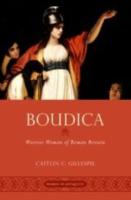
OUP (2018) h/b 210pp £53.00 (ISBN 9780190609078)
Boudica has been a long time coming; she finally gets to rub shoulders with the likes of Cleopatra VII, Hypatia, Theodora, Arsinoe and Galla Placidia in the OUP series, Women in Antiquity, assembled under the formidable editorship of Ronnie Ancona and Sarah Pomeroy. G. is a lecturer in the Department of Classics at Columbia University; other authors in this prestigious series include Barbara Levick (Faustina I and II), Marilyn Skinner (Clodia Metelli), and Gillian Clark (Monica).
The book, a ‘comparative literary biography’, has seven chapters, a valuable eighteen page bibliography taking us up to 2016—an indication of OUP’s slow production process?—the typically stingy five page OUP index and twenty-eight pages of notes. The three maps are clear and helpful, the illustrations are apt and support the text well.
The book is sub-titled ‘Warrior Woman of Roman Britain’ partly, I assume, to differentiate it from all the other books written about this peerless and formidable British woman: Boudica must be the second most published woman in the classical world after Cleopatra VII, so what does Caitlin Gillespie’s book bring to the already groaning shelf?
The author states that her focus is on clarifying how the at once melodramatic and measured, but almost mutually exclusive, manipulated and self-serving agenda-ridden accounts of Tacitus and Dio coalesce to forge an image of a woman who is both maternal and murderous. In the words of Tacitus and Dio, she symbolizes laudable elements of the Roman matrona and of the deplorable fatale monstrum that was Cleopatra. Tacitus tends towards the more civilised and admirable qualities in the woman, Dio towards the destabilising and barbarian.
One of the strengths of G.’s biography is that, to reinforce her picture of Boudica, she also compares the two historians’ accounts with what was actually going on in contemporary Imperial politics and society. Glimpses of Veleda, Cartimandua, Caratacus, Calgacus, Messalina, Nero and Agrippina the Younger all serve, by comparison, to sharpen her focus.
Chapters 1 and 2 provide the usual and necessary historical and political time-frame and background detail on the Iceni and their society—not least female leadership in the ‘context of Roman Imperial expansion’. Boudica’s battle speech, as delivered first by Tacitus and then by Dio, is dissected. This follows Tacitus’ description of her as a dutiful matrona and a woman fighting for the freedom of her people, which contrasts with Dio’s picture of a dangerous, powerful warrior quite at odds with what was expected of a Roman woman.
Illuminating comparisons with the cause and effect of other revolts in the early Empire conclude the book.
Paul Chrystal
